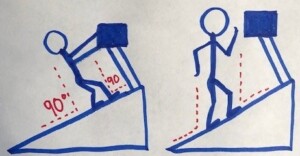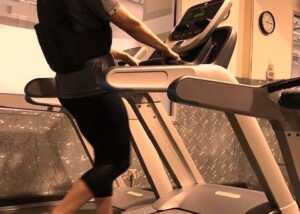Are you going batty wondering why you haven’t lost much weight after all those high incline sessions on the treadmill?
There’s a definite reason why, despite walking endless miles on a high treadmill incline, you haven’t lost much weight.
In fact, maybe you’re even still the same weight as when you began months ago on your quest to slim down.
If you’ve been religiously sticking to a program of using a high treadmill incline yet the anticipated weight loss hasn’t happened, I bet anything that your hands are glued to the machine’s bar or side rails the entire time!
This common treadmill error “un-inclines” the incline, because it causes your body to lean back, creating the same angle relationship with the tread as you’d have if you were walking with a zero incline.

Left: Make-believe incline walking. Right: Actual incline walking.
Not only that, but holding on, whether there’s an incline or not, significantly reduces the workload.
So though the calorie readout may show a big number at the end of an hour, that number is much higher than the calories you actually burned.
When you hold onto a treadmill, especially when it’s set to high incline, the treadmill itself takes over some of the exercise.
The worst offense takes the form of gripping the front bar with straight, locked-out arms.
The pronounced hip and knee flexion that takes place during true uphill walking is absent because, as mentioned, the body is angled way back.
This leaning-back makes your body perpendicular to the tread surface, even though the incline is high.
To reap weight loss from an incline, your body must be vertical, which will then force increased hip and knee flexion.
To make your body vertical, let go of the treadmill!

Source: Freepik.com
But you’ll get thrown right off the tread if you do, right? Solution: Slow the speed. A speed of 4 mph, even 3.5 mph, is way too fast for a sustained walk at a 15 percent incline. It’s not realistic.
Even seasoned hikers rarely sustain this kind of speed on a hill with a 15 percent grade.
A more realistic speed for a 15 percent incline is 1 to 1.5 mph if you want to sustain it for 30 minutes.
If you think that’s two slow, give it a try! I’m betting you’ll have to drop the incline to 5 percent within 15 minutes. Yes, I’m serious.
Holding onto a Treadmill = Ineffective Weight Loss Plan
Another problem with the locked-out, straight-arm hold is that this makes the bones in the arms become anchors to the bar.
Do you realize just how strong bones are when they’re used like this?
The bones absorb significant resistance; you’re not actually climbing that incline:
Rather, your feet are merely grazing along while the bones in your arms absorb the forces.
To understand this concept, look at it this way: What’s easier?
Hanging on a pull-up bar with your arms very bent? Or hanging with straight arms?
What about leaning forward while holding on so that the body is more vertical?
Some people who hold onto the bar or console while using an incline will pull forward with bent arms, but then the muscles in their arms and shoulders take over some of the work.
So even though their body is vertical, they’re still not genuinely climbing because they’re pulling themselves into that vertical position.
When you use a high treadmill incline the right way, you can lose a lot of weight.
If you think walking a high incline is too hard, then use a slower speed.
Easy exercise will not result in the weight loss you so desperately want.
 Lorra Garrick is a former personal trainer certified through the American Council on Exercise. At Bally Total Fitness she trained women and men of all ages for fat loss, muscle building, fitness and improved health.
Lorra Garrick is a former personal trainer certified through the American Council on Exercise. At Bally Total Fitness she trained women and men of all ages for fat loss, muscle building, fitness and improved health.
.



























